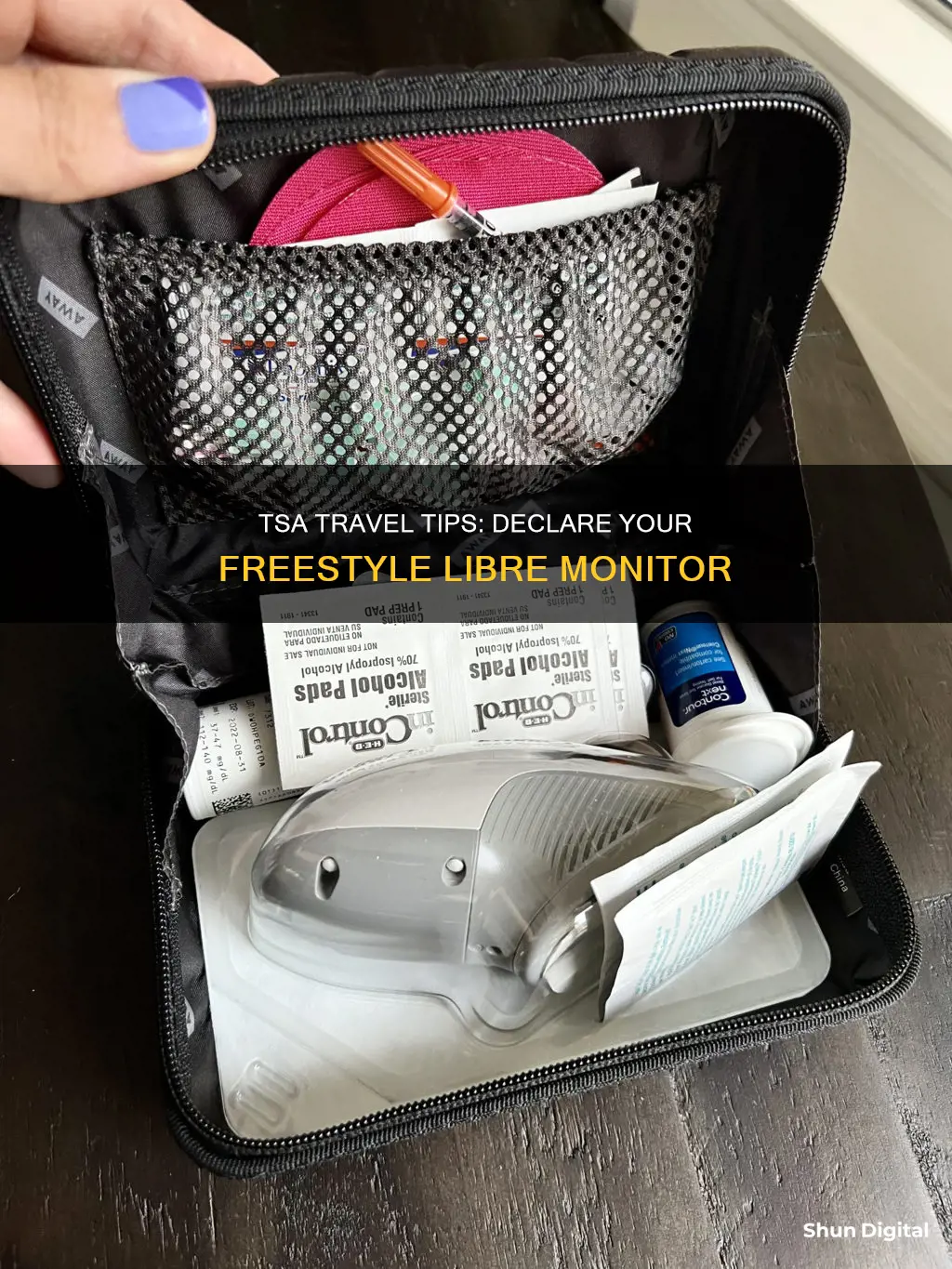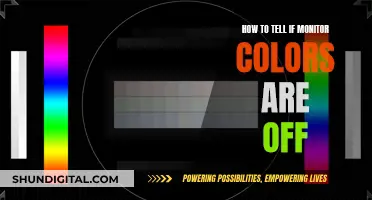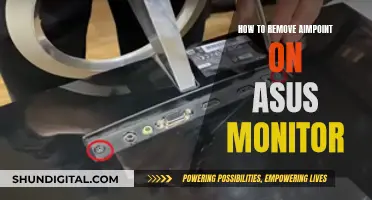
If you use a FreeStyle Libre monitor and are planning to travel, it's important to know how to handle the device when going through airport security. The FreeStyle Libre monitor is a continuous glucose monitoring system that helps people with diabetes manage their blood sugar levels. While it is safe to take this device through airport metal detectors, it should not be exposed to certain airport full-body scanners, such as those that use x-ray or millimetre radio waves, as this may damage the sensor or cause inaccurate results. To avoid removing your sensor, you should notify a security officer before proceeding through the airport security checkpoint and request an alternative type of screening. It is also recommended to keep extra sensors in your carry-on luggage and to check your airline's policy on NFC and Bluetooth devices.
| Characteristics | Values |
|---|---|
| Airport metal detectors | Can be exposed to airport metal detectors without removing the sensor |
| Airport full-body scanners | Should not be exposed to some airport full-body scanners (x-ray and millimeter radio-wave) |
| Requesting another type of screening | Notify the security officer before passing through the checkpoint to request another type of screening |
| TSA notification | Inform the TSA officers about your medical device before the screening process begins |
| TSA notification card | You can provide the TSA officers with a notification card prior to screening to discreetly describe your medical condition |
| Screening process | You will not be required to remove any medical devices attached to your body |
| Screening process | If you are wearing a glucose monitor, you may be required to conduct a self pat-down of the device, followed by a test of your hands for any trace of explosives |
| Screening process | Declare all medical equipment and separate them from your other belongings before screening begins |
| Screening process | Liquid medications are exempt from the TSA's 3-1-1 rule but will require additional screening |
| Screening process | You can use the FreeStyle Libre 3 system while on an aircraft, but the flight crew may decide if they do not want any electronic devices powered on |
What You'll Learn

Inform TSA officers about your diabetes before the security check
When travelling with diabetes, it's important to inform the TSA about your condition before the security check process begins. Here are some tips to help you navigate airport security with your Freestyle Libre monitor:
Firstly, you don't need to remove your Freestyle Libre monitor to go through security. The monitor can be exposed to common electrostatic (ESD) and electromagnetic interference (EMI), including airport metal detectors, without any issues. However, you should avoid exposing the monitor to certain airport full-body scanners, particularly those that use X-ray or millimetre radio-wave technology. These scanners may damage the monitor or cause inaccurate results. To avoid this, notify a TSA officer before you reach the checkpoint, and request an alternative type of screening, such as a pat-down inspection.
If you prefer to be discreet, you can fill out a disability notification card and hand it to the TSA officer performing your security check. This card will inform them that you have diabetes and require special accommodations. Additionally, if you are travelling with extra sensors, keep them in your carry-on bag and inform the TSA officer that they cannot be exposed to X-ray machines and will need to be hand-inspected.
It is also recommended that you keep your insulin and other supplies in your carry-on bag, as you should have access to them at all times. Make sure to declare these items and separate them from your other belongings before the screening process begins. Liquid medications, such as insulin, are exempt from the TSA's 3-1-1 rule, but they will require additional screening.
By following these guidelines and informing the TSA about your diabetes and Freestyle Libre monitor, you can help ensure that your security check process goes smoothly and that your equipment remains safe and functional.
Breaking an LCD Monitor: Step-by-Step Guide
You may want to see also

Request another type of screening to avoid removing the sensor
If you are wearing a FreeStyle Libre sensor, you should not be exposed to airport full-body scanners that include X-ray or millimetre radio waves. This type of scanner may cause damage to the sensor or lead to inaccurate results. To avoid removing your sensor, you can request another type of screening. Here are some tips to ensure a smooth experience when travelling with your FreeStyle Libre sensor:
- Notify the Security Officer: Prior to proceeding through the airport security checkpoint, inform the Security Officer that you are wearing a medical device. Specifically, mention that you are wearing the FreeStyle Libre sensor, which cannot be exposed to certain scanners.
- Request an Alternative Screening Method: Ask the Security Officer for an alternative screening method that does not involve removing your sensor. You may be offered a pat-down inspection or a walk-through metal detector as an alternative to the full-body scanner.
- Provide a TSA Notification Card: If you prefer to be discreet, you can fill out a disability notification card and hand it to the TSA officer before the security check. This card will discreetly describe your medical condition and the need for an alternative screening method.
- Declare Medical Equipment: Ensure that you declare all medical equipment and medications before the screening begins. Although not required to be removed, they will need to undergo separate screening.
- Keep Supplies Close By: Keep your insulin and other supplies in your carry-on bag. This ensures that you have access to them at all times and can easily present them for screening if needed.
- Be Prepared for Additional Screening: If you are wearing an insulin pump or glucose monitor, it may be subject to additional screening, including a visual inspection and a test of your hands for any trace of explosives.
- Inform Your Travelling Companions: It is a good idea to let the people you are travelling with know about your medical condition in case of a medical emergency.
- Wear a Medical Identification Bracelet: Consider wearing a medical ID bracelet, which can alert emergency medical staff of your condition.
- Consult Your Doctor: Before travelling, visit your doctor to get copies of your prescriptions and a letter describing your diagnosis and treatment needs. Ask about any adjustments you may need to make to your treatment during your travels.
Is Your Monitor Bluetooth-Enabled? Here's How to Tell
You may want to see also

Keep your Freestyle Libre monitor in your carry-on bag
If you use the FreeStyle Libre monitor, there are a few things to keep in mind when travelling by air. Firstly, always keep your monitor in your carry-on bag, along with any extra sensors. This is because your checked luggage may be exposed to extreme temperatures which could damage your monitor. Additionally, you will need easy access to your monitor and sensors throughout your journey.
When passing through airport security, you can keep your FreeStyle Libre monitor and sensor on your body while going through metal detectors. However, you should not pass through full-body scanners, as these may damage the sensor or cause inaccurate results. If you encounter a full-body scanner, notify the security officer and request an alternative type of screening. You may be required to conduct a self-pat-down of the device, followed by a test of your hands for any trace of explosives.
It is a good idea to let the Transportation Security Administration (TSA) know about your diabetes before you arrive at the airport, to help security checks go smoothly. You can do this by filling out a disability notification card and handing it to the TSA employee who is performing your security check. Alternatively, you can simply inform the TSA officers about your monitor and sensor before the screening process begins.
Finally, remember to bring your monitor's charger, and if you will be testing your glucose using fingersticks, pack something that can serve as a makeshift sharps container for your used needles and lancets, such as a hard pencil case.
Hooking up Three Monitors to a GTX 970: Ultimate Guide
You may want to see also

Declare all medical items and separate them from other belongings
When travelling with a FreeStyle Libre monitor, it is important to declare all medical items and separate them from other belongings. This includes any extra FreeStyle Libre sensors, which should be packed in your carry-on bag. It is also recommended that you check your airline's policy on NFC and Bluetooth devices and plan accordingly.
Before arriving at the airport, it is advisable to contact the Transportation Security Administration (TSA) to inform them about your diabetes and any medical devices you are carrying. This will help the security process go more smoothly. When you arrive at the checkpoint, let the TSA officers know about your medical device and any other equipment before the screening process begins. Although not required, you can provide them with a TSA notification card that discreetly describes your medical condition.
During the screening process, you will not be required to remove any medical devices attached to your body, such as an insulin or continuous glucose monitor. However, because X-ray machines can damage your device, the TSA recommends you request a pat-down inspection. If you are travelling with medical equipment or supplies, they will need to undergo separate screening. The TSA officer will check the supplies and conduct any necessary testing.
To avoid removing your FreeStyle Libre sensor, you should notify the Security Officer prior to proceeding through the airport security checkpoint and request another type of screening. The FreeStyle Libre sensor should not be exposed to some airport full-body scanners, including X-ray and millimetre radio-wave scanners. However, the sensor can be exposed to common electrostatic (ESD) and electromagnetic interference (EMI), including airport metal detectors.
Asus Monitor Model: A Quick Identification Guide
You may want to see also

Bring extra sensors in case of malfunction
When travelling with your FreeStyle Libre monitor, it is important to bring extra sensors in case of malfunction. Here are some detailed instructions and tips to ensure a smooth journey:
Firstly, always pack your extra FreeStyle Libre sensors in your carry-on bag. This is important for easy access and to avoid any potential issues with sensor availability during your trip. It is also recommended to check your airline's policy on NFC and Bluetooth devices, as you may need to adjust your settings or notify the relevant authorities in advance.
Secondly, be aware of the potential issues with airport security scanners. The FreeStyle Libre sensor can be exposed to common electrostatic (ESD) and electromagnetic interference (EMI), including airport metal detectors. You can safely walk through these metal detectors without removing your sensor. However, full-body scanners that use X-ray or millimetre radio waves can potentially damage your sensor or cause inaccurate results. To avoid any issues, notify the security officer prior to reaching the checkpoint and request an alternative type of screening.
Thirdly, ensure that your sensors are properly cared for and maintained during your travels. Keep your sensors in a safe place, away from extreme temperatures, as sensors that are too hot or too cold may malfunction. Additionally, make sure your skin is clean and dry before applying or reapplying a sensor, following the instructions provided. This will help ensure proper adhesion and reduce the risk of sensor malfunction.
Finally, be mindful of the sensor's compatibility with other devices. If you are using the FreeStyle LibreLink app, ensure that your smartphone is compatible and that you have the necessary apps installed and set up correctly. Additionally, if you are using an insulin pump, be aware of the specific considerations and guidelines for reconnecting your sensor after medical procedures such as MRI/CT/X-ray scans.
By following these instructions and bringing extra sensors, you can confidently travel with your FreeStyle Libre monitor and effectively manage your glucose monitoring needs.
Disassembling LG LCD Monitors: A Step-by-Step Guide
You may want to see also
Frequently asked questions
Yes, it is a good idea to inform the TSA about your Freestyle Libre monitor before they begin the security check process. You can also fill out a disability notification card to hand to the TSA employee to let them know about your monitor.
No, you will not be required to remove your monitor. However, X-ray machines and some full-body scanners can damage the monitor, so you should request a pat-down inspection or another type of screening.
You should pack any extra sensors in your carry-on bag. You will not be required to remove any medical devices attached to your body, but any medical equipment or supplies in your luggage will need to undergo separate screening.
Yes, you may use your Freestyle Libre monitor on the plane. However, aviation regulations dictate that a flight crew may decide whether they want electronic devices to be powered on during the flight.







